CHEVROLET CORVETTE 1993 4.G Owners Manual
Manufacturer: CHEVROLET, Model Year: 1993, Model line: CORVETTE, Model: CHEVROLET CORVETTE 1993 4.GPages: 370, PDF Size: 21.43 MB
Page 181 of 370
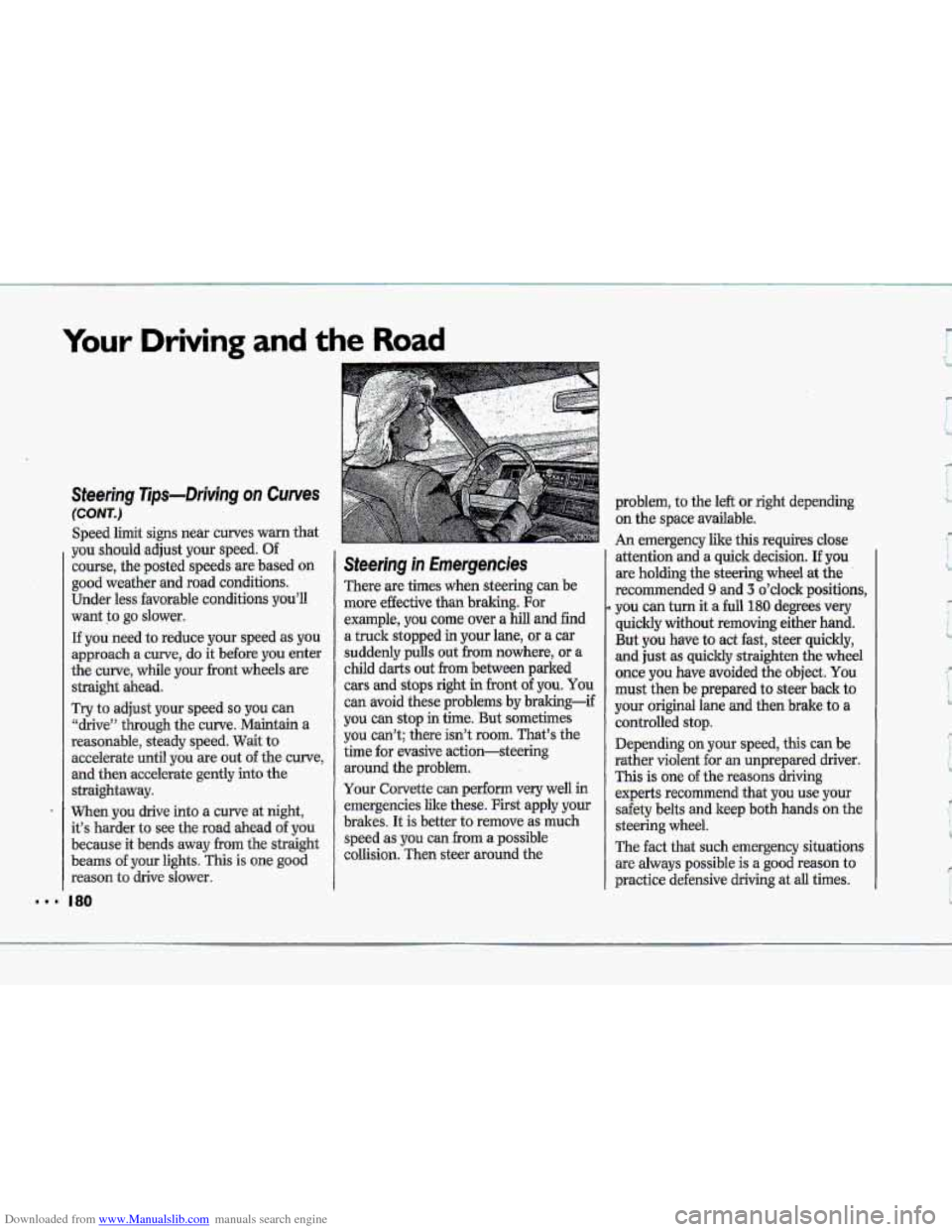
Downloaded from www.Manualslib.com manuals search engine ..I
Your Driving and the Road
’I
Steering Tips-Driving on Curves
(CONT.)
Speed limit signs near curves warm that
you should adjust your speed.
Of
course, the posted speeds are based on
good weather and road conditions.
Under less favorable conditions you’ll
want to
go slower.
If you need to reduce your speed as you
approach
a curve, do it before you enter
the curve, while your hont wheels are
straight ahead.
Try
to adjust your speed so you can
Wive” through the curve. Maintain a
reasonable, steady speed. Wait to
accelerate until you are out
of the curve,
and then accelerate gently into the
straightaway.
When you drive into
a curve at night,
it’s harder to see the road ahead
of you
because it bends away
from the straight
beams
of your lights. This is one good
reason to drive slower.
I80
Steering in Emergencies
There are times when steering can be
more effective than braking. For
example,
you come over a hill and find
a truck stopped
in your lane, or a car
suddenly pulls out
€ram nowhere, or a
child darts out from between parked
cars and stops right in front of you. You
can avoid these problems by braking-if
you can stop in time. But sometimes
you can’t; there isn’t
room. That’s the
time for evasive action-steering
around the problem.
Your Corvette
can perform very well in
emergencies like these. First apply your
brakes. It is better
to remove as much
speed as you can
from a possible
collision. Then steer around the
9
problem, to the left or right depending
on the space available.
An emergency like this requires close
attention and a quick decision.
If you
are holding the steering wheel at the
recommended
9 and 3 o’clock positions,
you can turn it a full 180 degrees very
quickly without removing either hand.
But you have to act fast, steer quickly,
and just as quickly straighten the wheel
once
you have avoided the object. You
must then be prepared to steer back to
your original lane and then brake to a
controlled stop.
Depending on your speed, this can be
rather violent for an unprepared driver.
This is one of the reasons driving
experts recommend that you use your
safety belts and keep both hands
on the
steering wheel.
The fact that such emergency situations
are always possible is
a good reason to
practice defensive driving at
all times.
Page 182 of 370
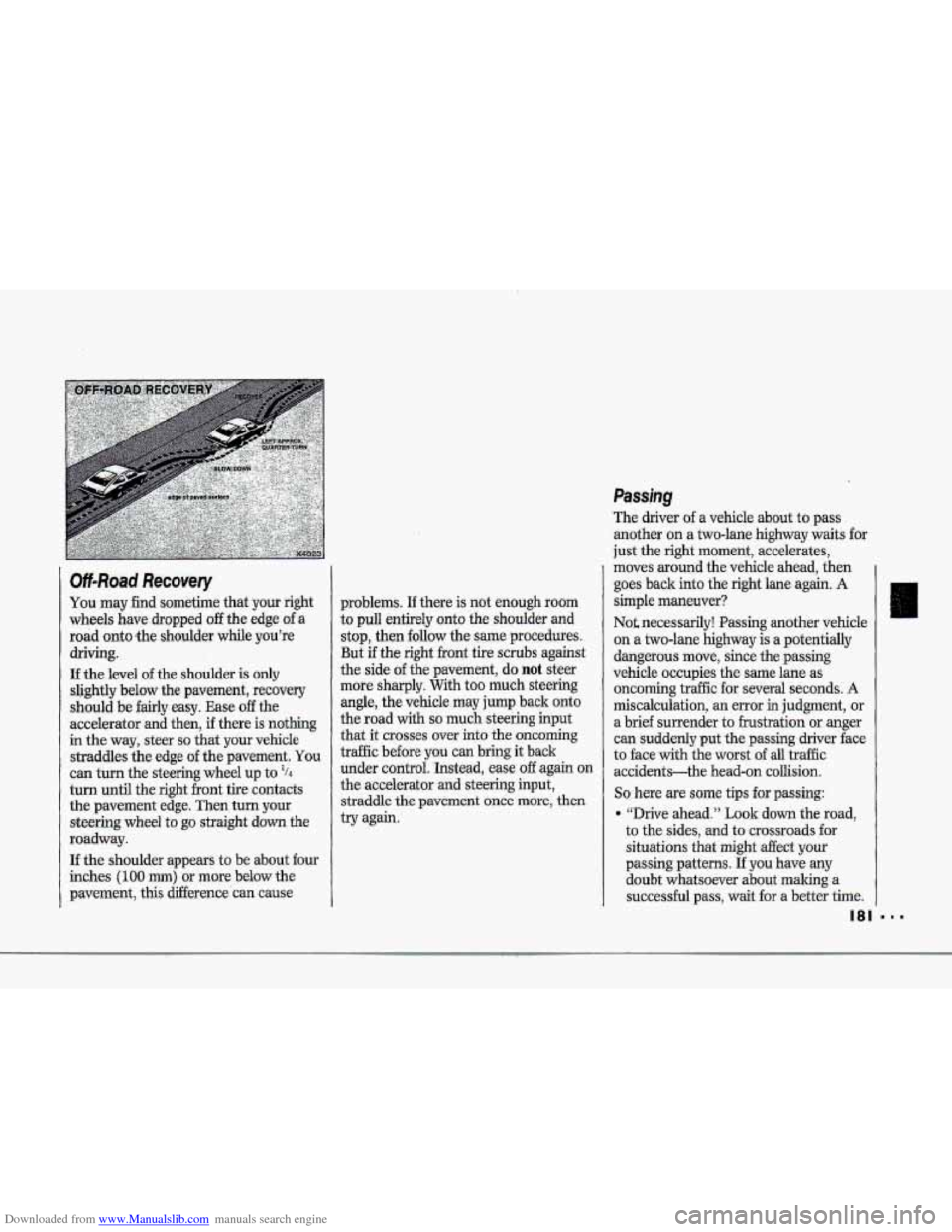
Downloaded from www.Manualslib.com manuals search engine T
i
,+
I i
r.
!
Ofl-Road .Recovery
You may hd sometime that your right
wheels bave dropped 08 the edge of-a
road mtwthe &odder while you’re
driving.
ff- the level of the shoulder is only
slightly below the pavement, recovery
should be fairly easy. Ease off the
accelerator and then, if there is nothing
in the way, steer so that. your%Wde
straddles the edge of. the pavement. You
can turn the steering wheel up to ‘h
turn until theight. front tire contacts
the pavement
edge. Then turn your
stetking wheel to go straight dm the
rcradway.
If the- shoulder appears to be about four
inches (100 mm) or more below the
pavement,. this difference.cm cause
problems. If there is not boough room
to pull entirely onto the shoulder and
stgp, then fdbw the same procedures.
But if the riglit €rant tire scrubs against
the side. af the pavement, do not skstr
more.sharplyy. With too much steering-
angle, the vehicle may jump back o~to
the road with so much steering input
that it-cmsses over into the oncoming
tr&c ,before you can bring it back
under control.. ;Instead, ease off again an
the? accelerator and steeping input,
straddle
the pavement once more, then
try again.
Page 183 of 370
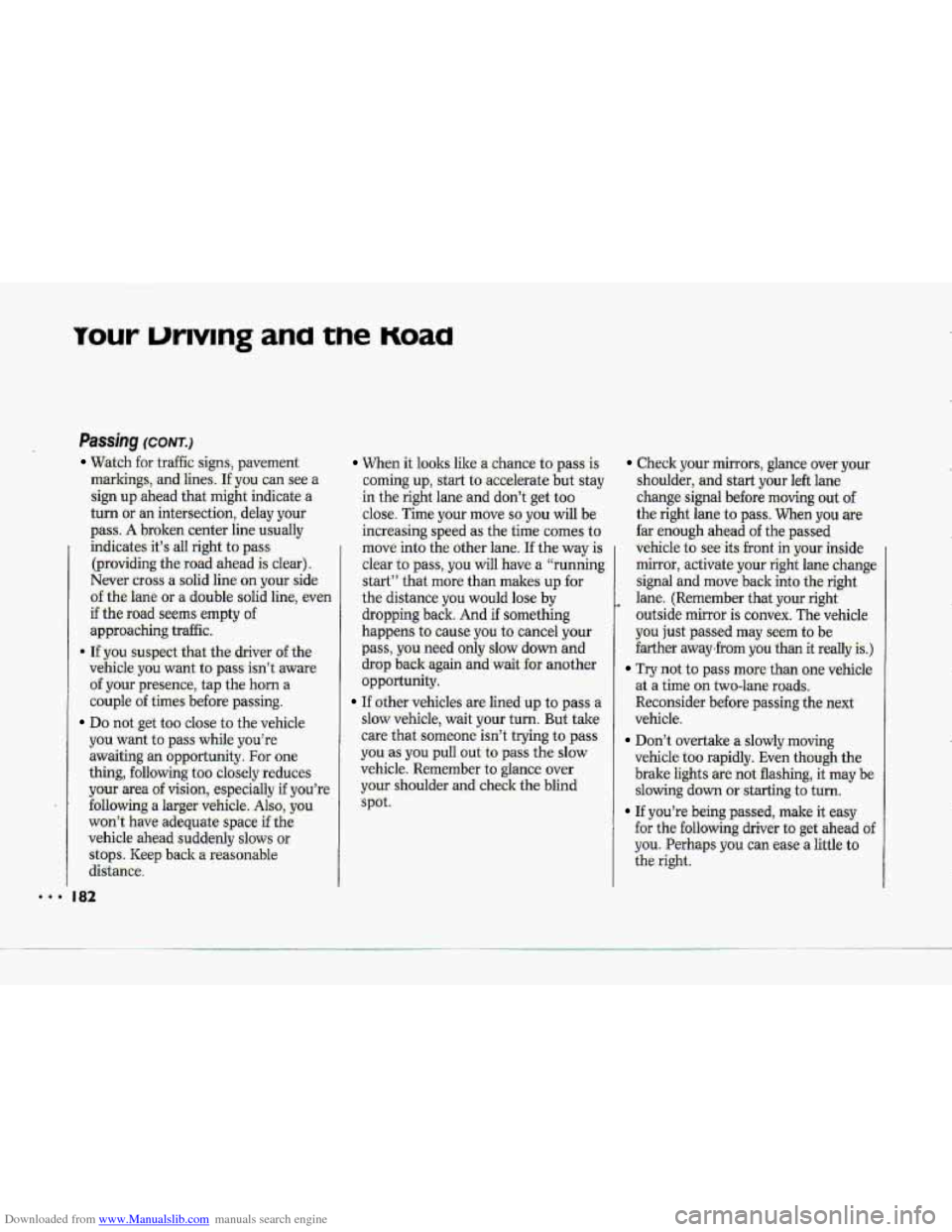
Downloaded from www.Manualslib.com manuals search engine row urlvrng ana tne noaa
‘I
PaSShg (COW.)
Watch for traffic signs, pavement
markings,
-and lines. If you can see a
sign
up ahead that might indicate a
turn
or an intersection, delay your
pass. A broken center line usually
indicates -it’s all right
to pass,
(providing the road ahead
is clear).
Never cross a solid line on.your side
of the lane or a double solid line, even
if the road seems empty of
approaching traffic.
* If you suspect that the- driver of the
vehicle
you want to. pass isn’t .aware
of-your presence, tap the horn a
couple of times before. passing.
Do not.get too close- to the vehicle
you want
to pass while you’re
awaiting an opportunity. For one
thing, following tQo closely reduces
your area
of vision, especi-ally if you’re
following
a larger vehicle. Also, you
won’t have adequate space if the
vehicle
,ahead suddenly slows dr
stops. Keep back a- reasonable
distance.
I 82
When it 1cr.oks like a chance to:pass is
.doming up, start to-accelerate but stay
in the- right lane and don’t -get- too
close. Time your move so, you will be
increasing speed as’the time comes to
move into the other
lane.3 the. way is
clear to pass, you will have a “running
start’” that
more than makes up fix
the distance you would lose by
dropping back. And
if something
happens to Cause you to cancel your
pass, you need only slow down and
drop back again and wait for another
opportunity.
If other vehicles .are lined up to pass a
slow vehicle, wait your turn. But: take
care that someone- isn’t trying to pass
you as you pull out to pass the slow
vehicle. Remember to glance, over
your shoulder andxheck the blind
spot.
Check your mirr-ors, glance over your
shoulder, aad start your left lane
change-,signal before
,moving aut of
the right lane to pass. When you are
far enough ahead of the. passed
vehicle to see-its front in your inside
mirror, activate.your right lane ,change
signal
and move back into the right
lane; (Remember that-your right
0-utside mirror is-convex. The vehicle
you just passed ‘may seem to be
farther away+from you than it redly
is.)
Try n0t.t.o pass more than one vehicle
at a time on two-lane roads.
Reconsider before passing the next
vehicle.
.vehicle too rapidly. Even though the
brake lights. are not flashing, it may be
slowing dawn or starting to turn.
If you’re- being passed, make it easy
for the following. driver to get ahead
of
you. Perhaps you can ease. a little to
the right;
Don’t overtake a slowly .m,oving
Page 184 of 370
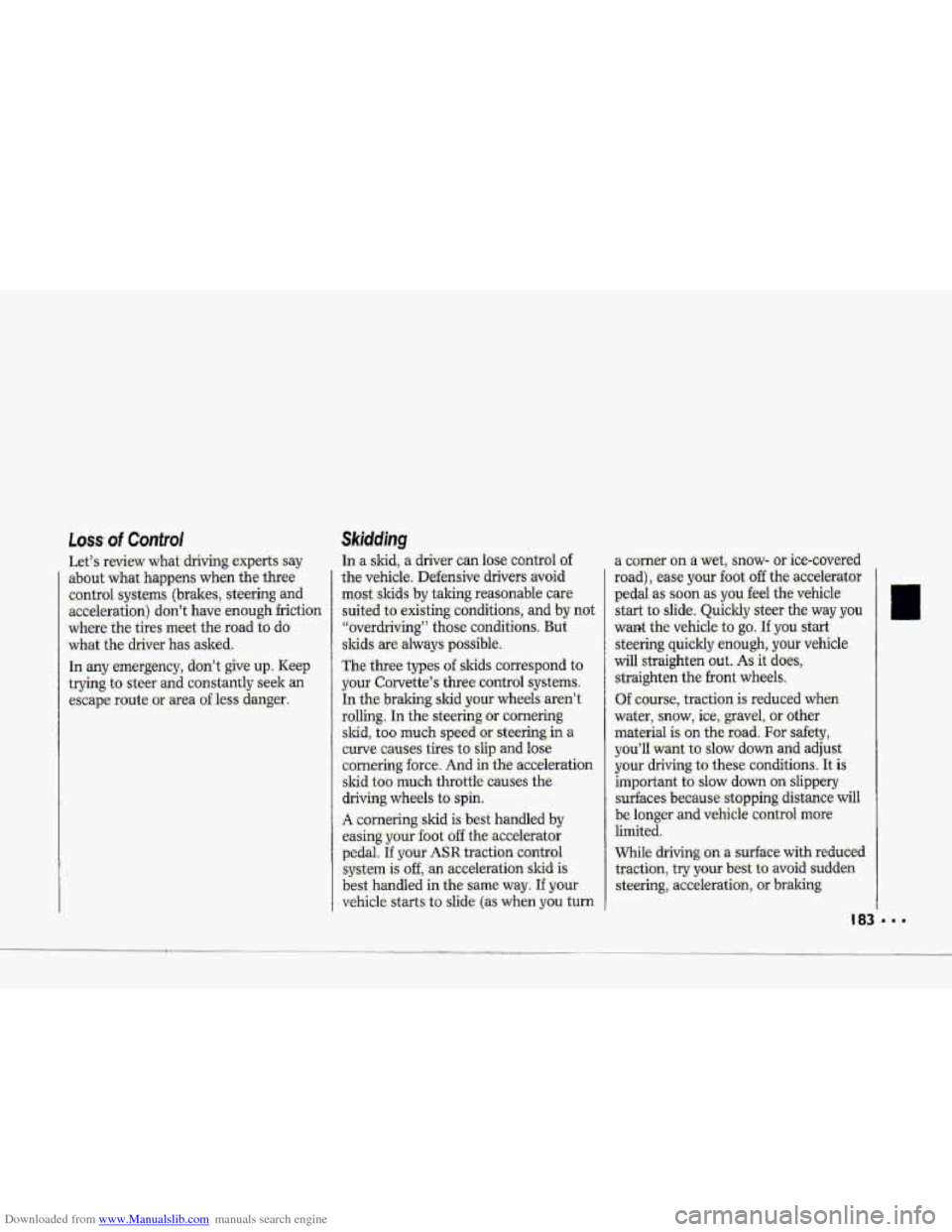
Downloaded from www.Manualslib.com manuals search engine w-
Loss. of Control
Let’s review what- driving experts say
about what ha-ppens when the three
cuntrd systems
(brakes, steering and
acceleration) dodt have enough hictior
where the tires meet the road to do
what the driver has asked,
In any emergency, don’t give up. Keep
trying to- steer and constantly seek an
escape r.oute.oy area of less danger.
Page 185 of 370
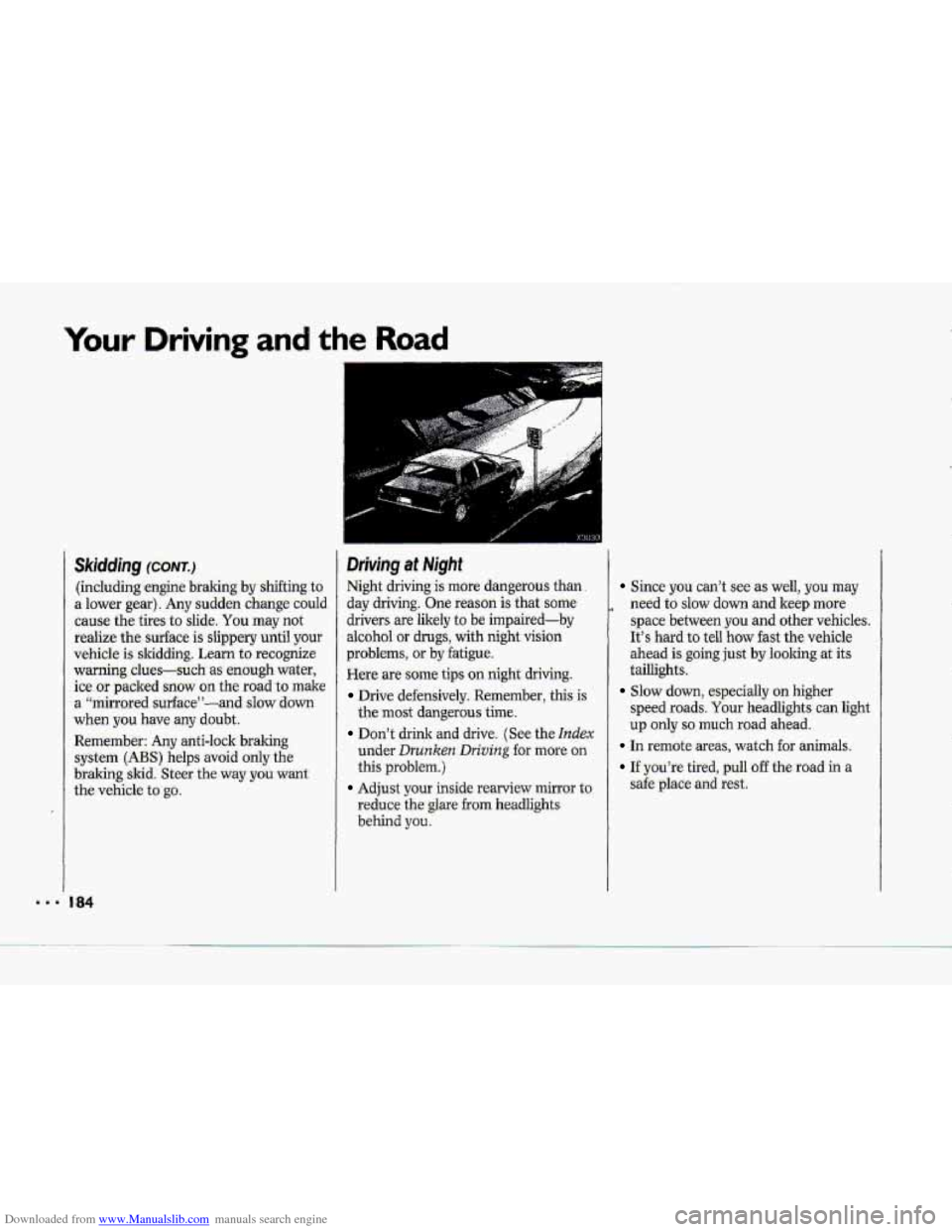
Downloaded from www.Manualslib.com manuals search engine Your Driving and the Road
Skidding (CONT.)
(including engine braking by shifting to
a lower gear). Any sudden change could
cause the tires
to slide. You may not
realize
the surface is slippery until your
vehicle
is skidding. Learn to recognize
warning clues-such as enough water,
ice or packed snow
on the road to make
a ‘‘mirrored surface”-and slow down
when you have any doubt.
Remember: Any anti-lock braking
system
(ABS) helps avoid only the
bralung skid.
Steer the way you want
the vehicle to
go.
Driving at Night
Night driving is more dangerous than.
day driving. One reason is that some
drivers are likely
to be impaired-by
alcohol or drugs, with night vision
problems, or by fatigue.
Here are some tips
on night driving.
Drive defensively. Remember, this is
the most dangerous time.
Don’t drink and drive. (See the Index
under Drunken Dn’ving for mure on
this problem.)
Adjust your inside rearview mirror to
reduce
the glare from headlights
behind you.
Since you can’t see as well, you may
need
to slow down and keep more
space between you and other vehicles.
It’s hard to teil how fast the vehicle
ahead
is going just by looking at its
taillights.
speed roads. Your headlights can light
up only so much road ahead.
Slow down, especially on higher
In remote areas, watch for animals.
If you’re tired, pull off the road in a
safe place and rest.
Page 186 of 370
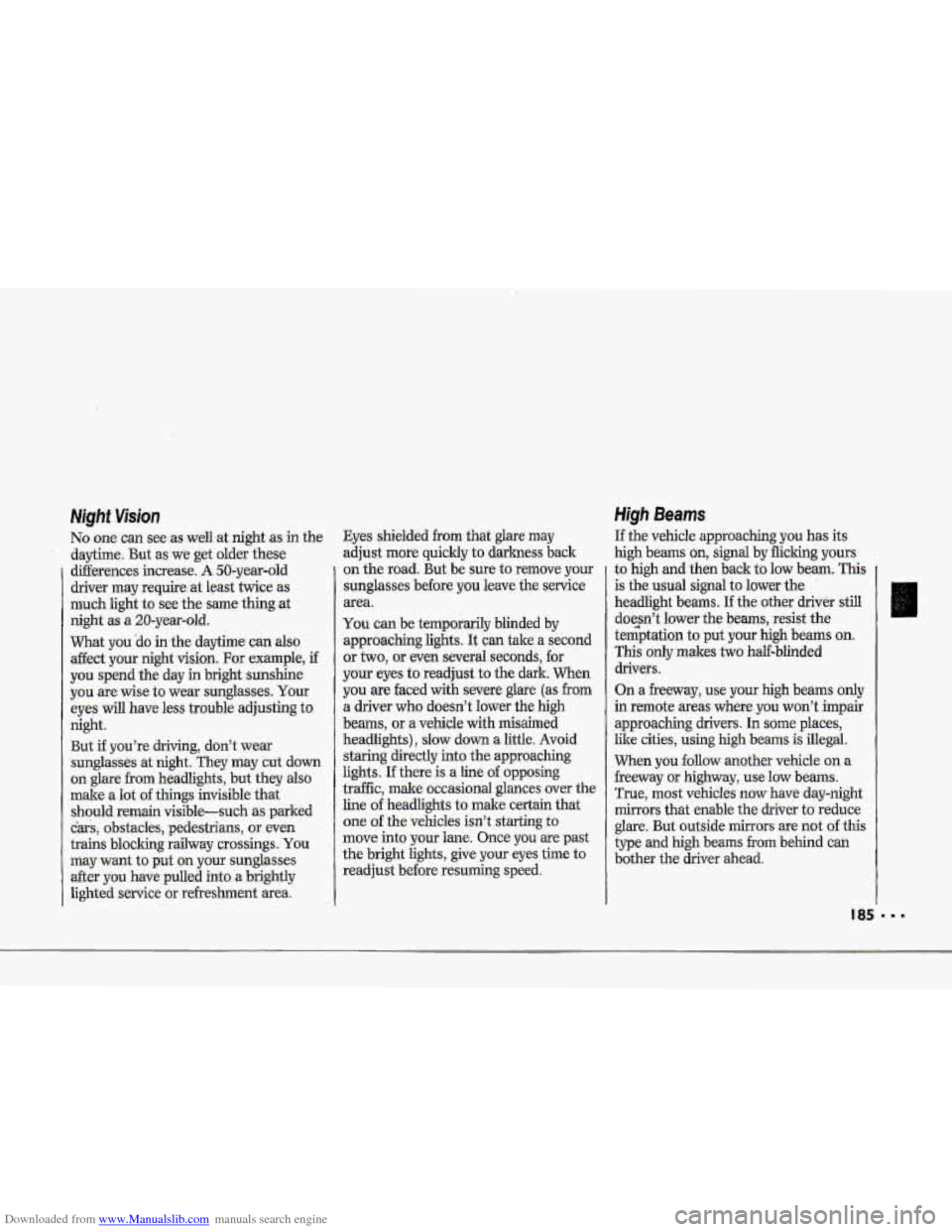
Downloaded from www.Manualslib.com manuals search engine i
r; T
i
1 d
I“
Myht Vision
No one can see as well at night, as in the
daytime. But as
we get older -these
differences increase. A. 50-year-ald driver may require .at least twice as
much light to see the same thing at
night as a 20-year-old.
What you 80 in the daytime can also
&ct your night vision. For example, if
you spen-d-the day in bright sunshine
you
are wise to wear sunglasses. Your
eyes will have less trouble adjusting to
night.
But if you’re driving, don’t
wear
sunglasses at night. They may cut down
on glare from headlights, but they also
make
a lot of things invisible that
should
r.enmin visible-such as parked
cars, obstacles, pedestrians, or even
trains blocking railway
crossings.. You
may want to put on your sunglasses
after you have pulled into a brightly
lighted service or refreshment area.
Eyes shielded from that glare may
adjust more quickly to darkness back
on the road, But be sure to remove your
sunglasses before
you .leave the service
area.
You can be temporarily blinded by
approaching lights. It
can take a second
or
two, or even several seconds, for
your eyes to readjust to the dark. When
you are faced with severe glare (as from
a driver who doesn’t lower the high
beams,
or a vehicle with misaimed
headlights),
slow down a little. Avoid
-staring directly into the approaching
lights. If there is a line of opposing
traffic, make occasional glances
over the
line of headlights to make certain that
one
of the vehicles isn’t starting to
move into your lane. Once you .are past
the bright lights, give your eyes time
to
readjust before resuming speed.
High Beams
If the vehicle approaching-you has its
high beams on, signal by fliclcing yours
to high and then back to low beam. This
is the usual signal to lower the
headlight beams. zf.the other
driver still
doesn’t lower the
beams, resist the
ternaptation to. put
your high beams on.
This only makes two ha-blinded
drivers.
On a freeway, use your high beams only
in remote axeas where you won’t impair
approaching drivers.
In some p€aces,
like cities, using high beams is illegal.
When you follow another vehicle on a
freeway
or highway, use low beams.
True, most vehicles
now have day-night
mirrors that enable the driver to reduce
glare. But outside
mirrors are not of this
type and high beams
from behind can
bother the driver ahead.
Page 187 of 370
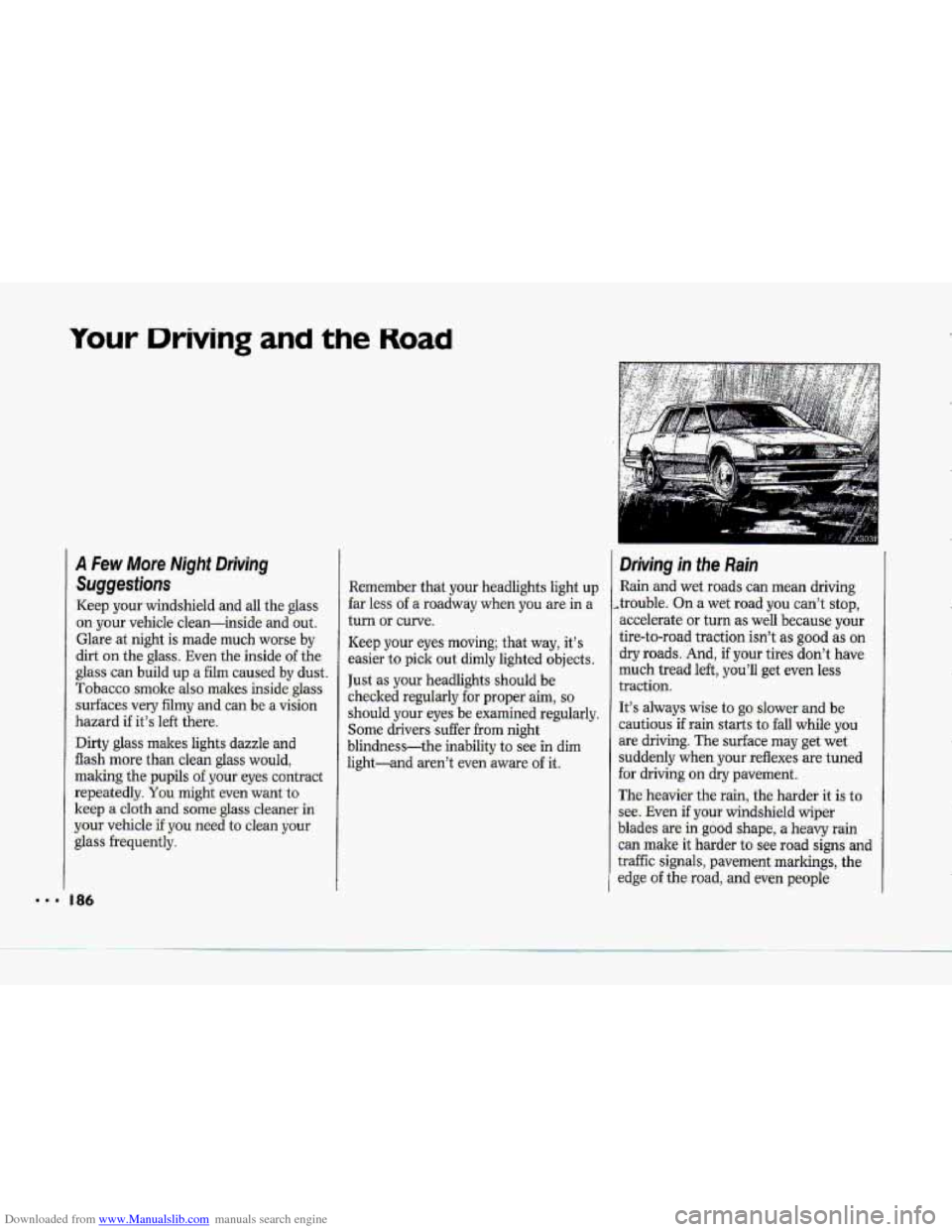
Downloaded from www.Manualslib.com manuals search engine Your Driving and the Road
Remember that your hedlights light up
€arless of a roadway when you are .in a
turn or cuwe.
Keep your eyes: moving; that way, it's
easier to pick aut d.imly lighted objects.
Just as sour headlights should be
checked regulaily-far proper aim, so;
should your .eyes be mmined regularly.
Some drivers suffer from night
blindness-the inabiIity to
see in dim
light-and
wen? even aware .of it,
b '
c..
Driving in the.Rain
-Rainiand wet roads can mestll dtiving
,.trouble. On a wet road you can'-t stop.,
accelerate
or turn as well because your
tire-to-roacl traction.
isn't as good as on
dry roads. And, if your tires don't have
traction.
It% always wise t;p g~ slower and be
cautious'if rai.n starts to fall While ybir
are driving. The surface may get wet
suddenly when. your:reflexes are. tuned
far driving CI~ dry pavement.
Thei;he.avier. the rain,
the hatdef it is to-
see. Eveh if your windshield wiper
blades are in good shape, a heavy rain
can male it harder to see road signs and
traffic signals, pavement markings, the
edge of the road, and even pegple
much tread left, youl~ get even less
Page 188 of 370
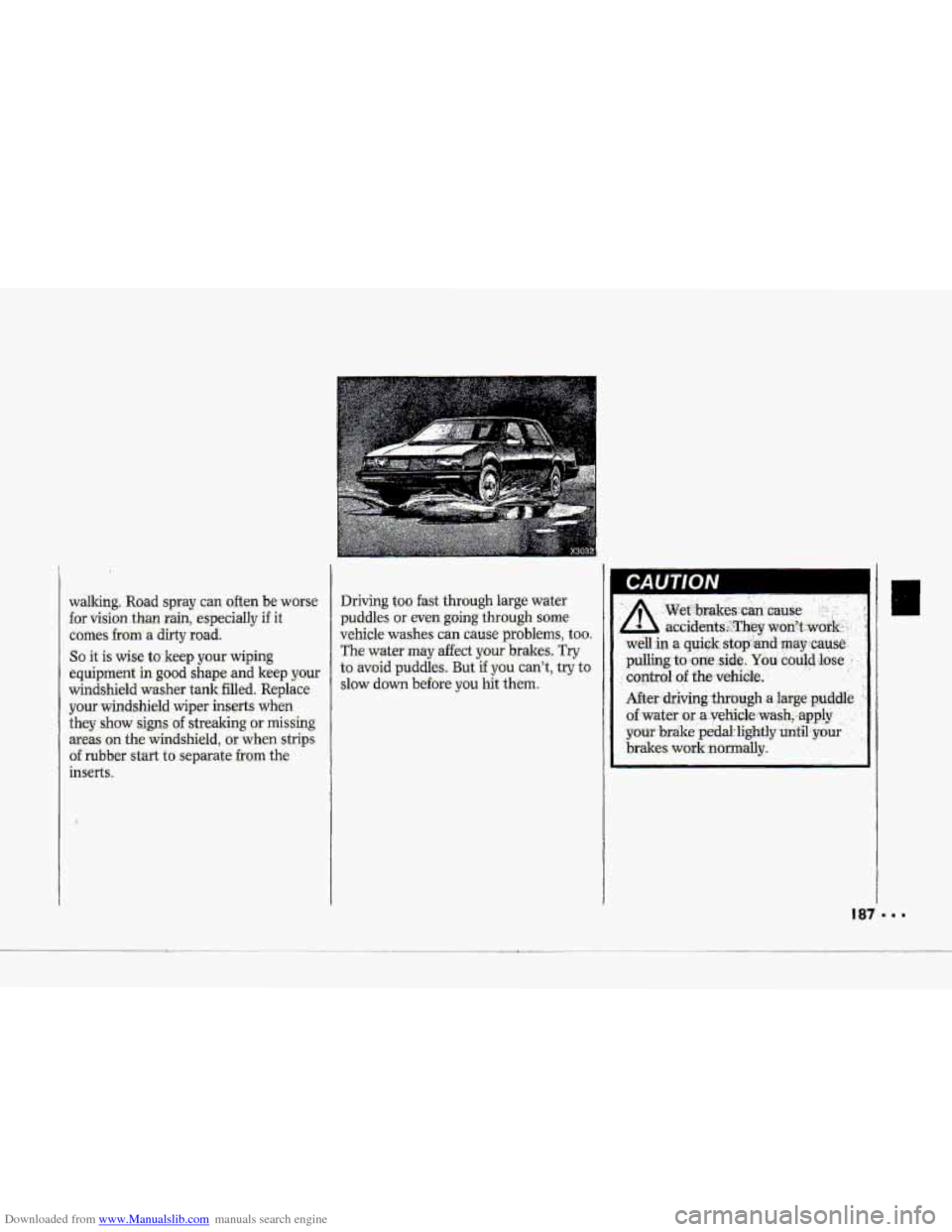
Downloaded from www.Manualslib.com manuals search engine a
birr
walking. 'Rad spray can often be worse
for vision than rain, especially if it
comes from: a dirty road:
So it is wise to keep your wiping
equipment in good shape and keep your
windshield washer tank-filled. Replace
your windshield wiper inserts when
they
show signs of streaking or missing:
areas on the wind,shi.eld, or when strips
of rubber start to separate from the
inserts.
Driving too fast through large water
puddles or even going
through some
vehiclewashes
em cause problems, too.
The water..may affect your 'brakes. Try
to avoid puddles. But if you can't, try to
slow down before you hit them.
I
I
Page 189 of 370
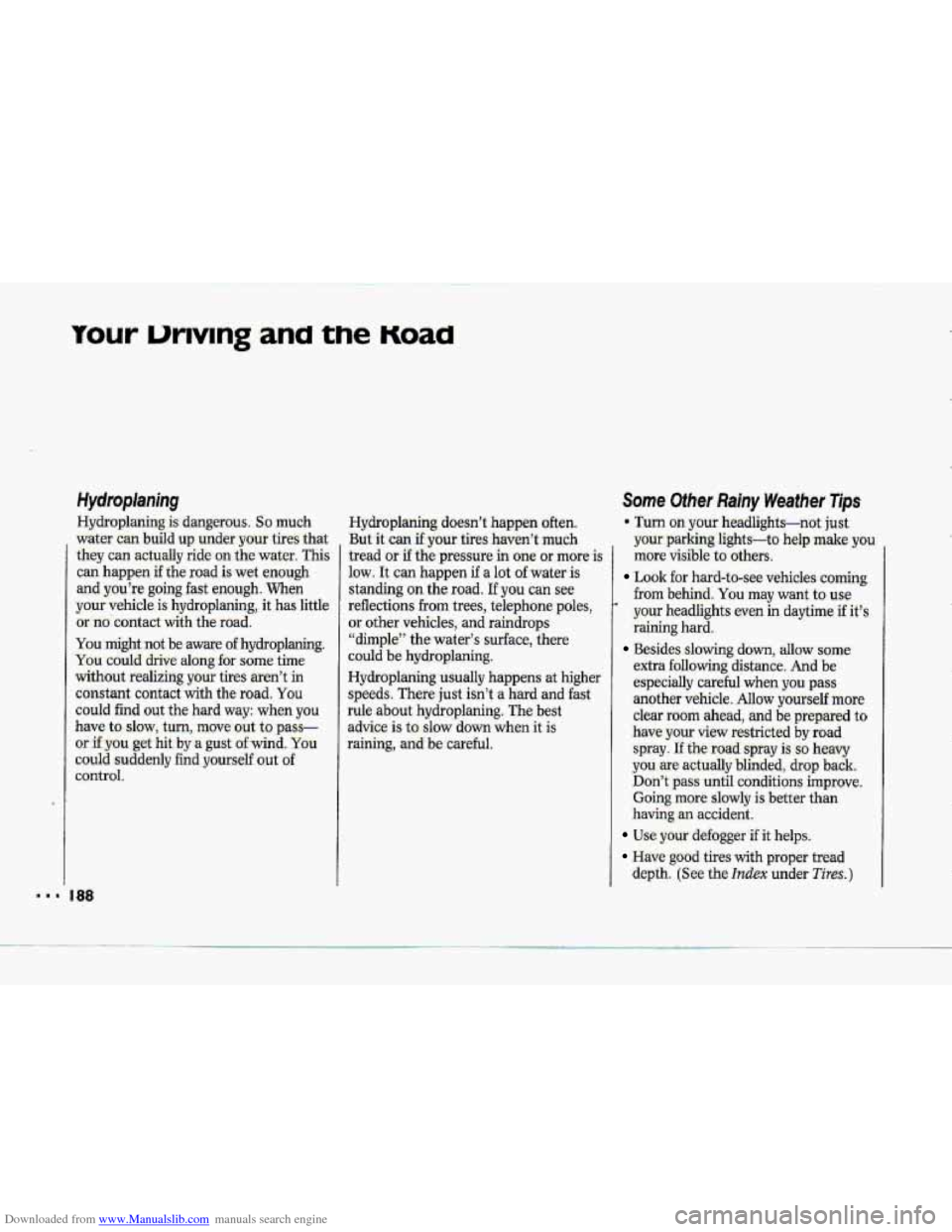
Downloaded from www.Manualslib.com manuals search engine your unvrng ana the Koad
‘I
Hydroplaning
Hydroplaning is dangerous. So much
water
can build up under your tires that
they can actually ride-on the-water. This
can happen
if the road is wet enough
and you’re going-fast enough. When
youi vehi-cle. is hydroplaning, it
has little
or no-contact with the road.
You
might. not be aware of hydroplaning.
You could drive along
for some time
without realizing your tires aren’t in
constant contact with the road.
You
could find out the hard way: when you
have to slow, turn, move out to pass-
or
if .you get hit by-a gust of wind. You
could suddenly find yours& out of
control.
I88
Hydroplaning doesn’t happen often.
But it can if your tires haven’t much
tread
or if the pressure in one or more is
low. It can happen if a lot of water- is
standing on the road.
If you can see
reflections
from trees, telephone poles,
or other vehicles, and raindrops
“dimple” the water’s surface, there
could be hydroplaning.
Hydrop1anhg:usually happens at higher
speeds. There just isn’t a hard and fast
rule about hydroplaning. The best
advice is
to slow down when it is
raining, and be careful.
Some Other Rainy Weather Tips
9 Turn on your headlights-not just
your
parking lights-to help make you
more visible to -others.
Look for hard-to-see vehicles co-ming
from behind.
You may want to use
your headlights even in daytime if it’s
-raining hard.
Besides slo.wing down, allow some
extra follo~ng distance.
And‘be
especially careful when you pass
another vehicle. Allow yourself-more clear room ahead, and be prepared
to
have your view restricted by r-oad .
spray. If the road. spray is.50 heavy
you..are actually blinded, drop back.
.Don’t pass until conditions improve.
Going more slowly
is better than
having-an accident.
Use your defogger if it helps.
Have good tires with proper tread
depth. (See
the Index under Tires.)
Page 190 of 370
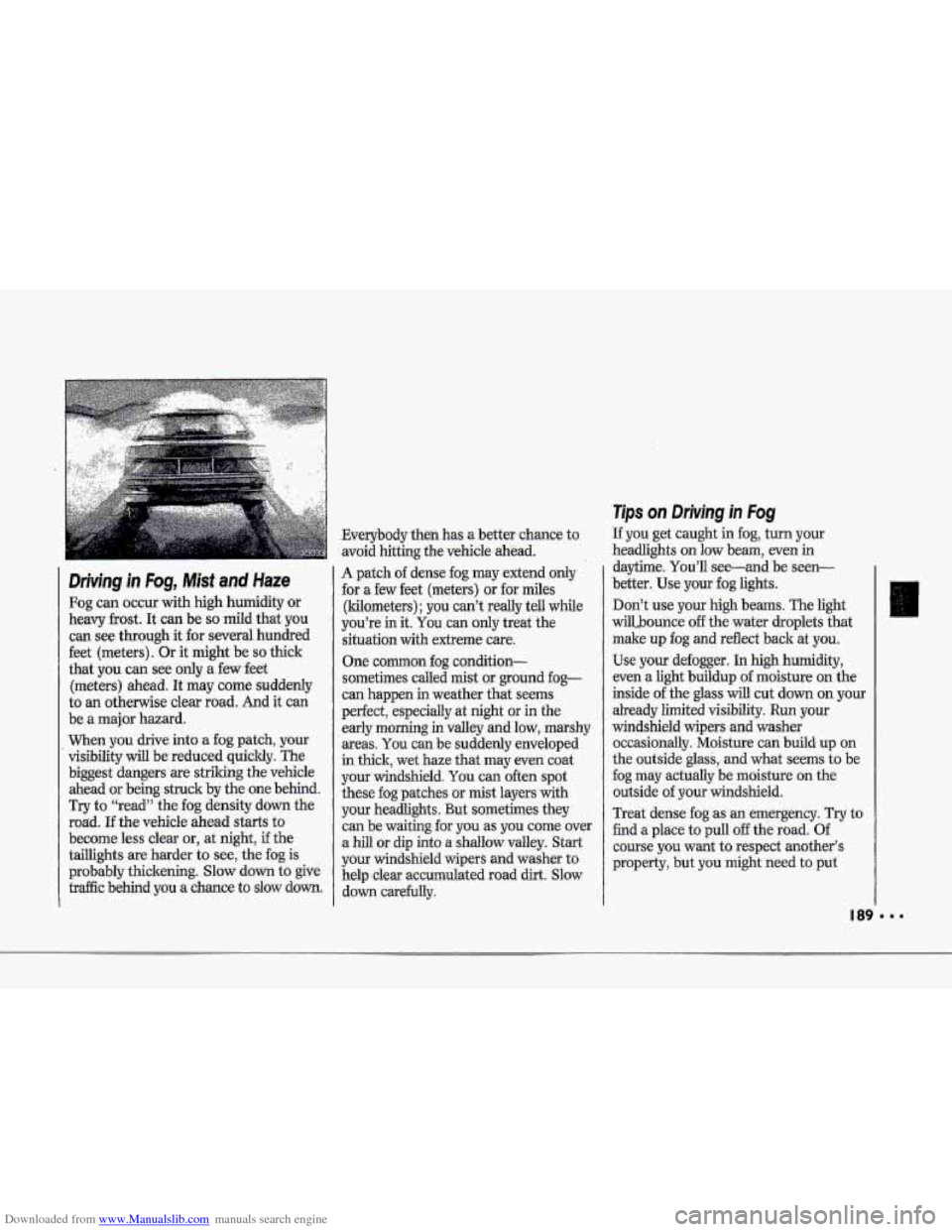
Downloaded from www.Manualslib.com manuals search engine 1””
I
I, ?
1, I I
.. .. -. . ,
Driving in Fag, lMfst and Haze
Fog can occur with high humidity or
heavy frost. It can be so mild that you
can see through it for several hundred
feet (meters). Or it might be so thick
that you
can s’ee only a few feet
(meters) ahead. It’may come suddenly
to an athenvise dear road. And it can
be a mjolc hazard.
When you drive into .a fog patch, your
visibility will be. reduced quickly. The
biggest dangers ‘are strilung. the vehicle
ahead or being struck by the one behind.
Tryto “read” the fog density down the
mad. If the vehicle ahead starts to
become less clear or, at night, if the
tai11,ights are hader to see, the fog is
probably thickning. Slow down to give
tr&c behind you a chance to -slaw.down.
Everybody then has a .betta -chance to
avoid hitting the vehide ahead.
A patch of dense fog may extend only
€or a few feet (meters) or for miles
(kilometers); you can’t really tell while
you’re
in it. You. can only treat the
situation with extrbme care.
One cornmon fog condition-
sometimes called mist or ground fag-
can happen in weather that .seems
perfect, especially
at night or in the
early
morning in valley and low, marshy
areas. You can be suddenly enveloped
in thick, wet haze that may even coat
your windshield.
You can often spot
these fog patches or mist layers with
YOW~ headlights. But sometimes they
can be waiting for you as you come over
a hill or dip into a shallow valley. Start
yaur
windshield wipers and washer to
help clear accumulated road
dirt. Slow
down carefully.
Tips on Driving in Fog
If you get caught in fog, turn your
headlights on low bearit, even in
daytime. You’ll see-and be seen-
better. Use your fdg lights.
Don’t
use your high beams. The light
wil1,bounce off the water droplets that
make up fog and reflect back at you.
Use your defogger. In high humidity,
even
a light buildup of moisture on the
inside of the glass will -cut down on your
already limited visibility. Runyour
windshield wipers .and washer
occas.itmdl.y. Moisture
c5u1 bui1d:up on
the outside. glass, and what .seems to be
fog may’actnrilly b-e-moisture on the
outside
of yoarwindshield.
Treat dense
fog as an emergency. Try to
find. a-place to
pull off the road, Of
course
you want to respect another’s
property, but you might need-to put